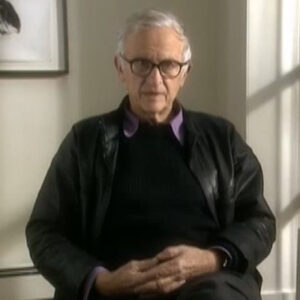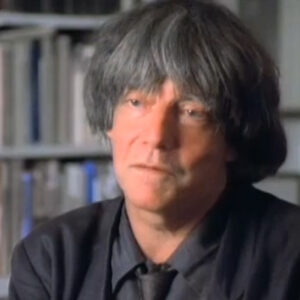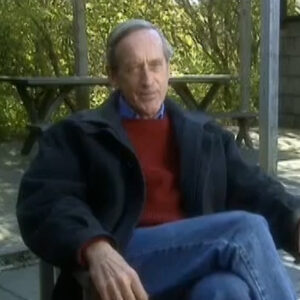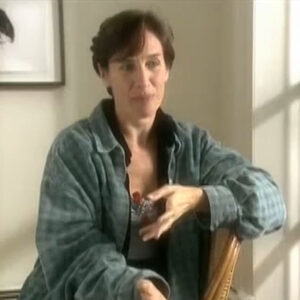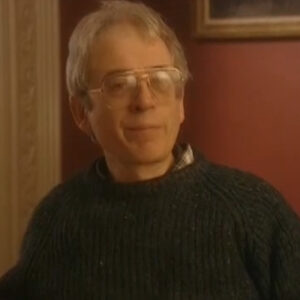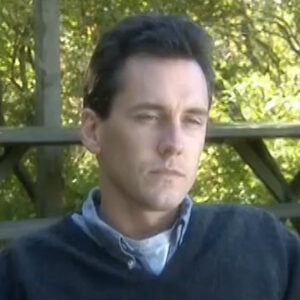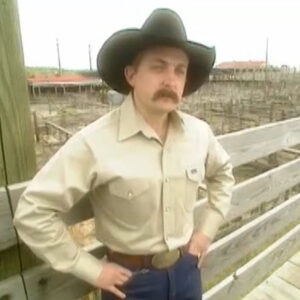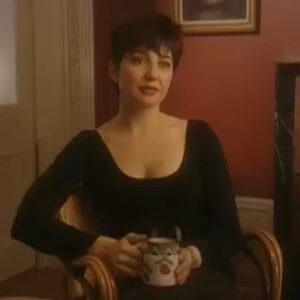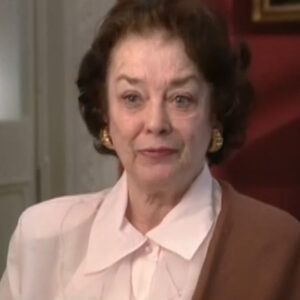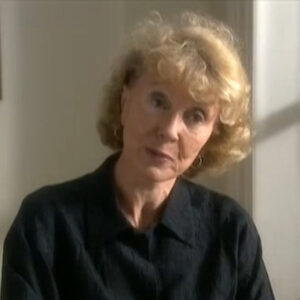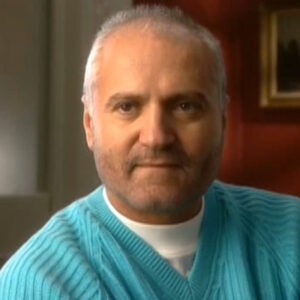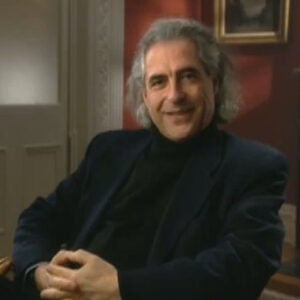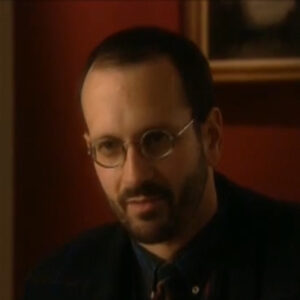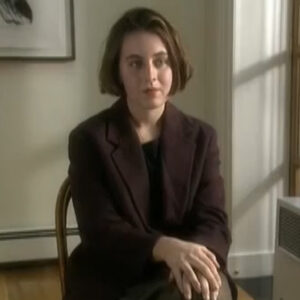Twyla Tharp: Right. That’s also recounted in the book. You know, we made this pile. I was a person who didn’t want to have their picture taken. I hate having my picture taken. I am of a primitive sort. I also am of a controlling sort and I don’t have control of the camera. Therefore, I was less than accommodating. And Dick was very wily and does arranged it in such a fashion that I would soon have to lose control and he would get a good picture. Which was a good thing to have done.
Interviewer: Yes, he said considerable resistance to the picture.
Twyla Tharp: Yeah, well, I think that a lot of people have this problem with photographers, especially people who are artists, because they are involved in creating their own imagery and are not so inclined to have someone take that capacity in that power from them. I mean, this was actually that sitting is actually the second the first thing we did was a solo sitting. And I was completely. What’s the right word? It goes beyond wooden and stone. Those are not strong enough. I mean, iron barely deals with a tear. And I was I was unwilling that anything should be given over that. I wouldn’t feel represented exactly what I would. My purpose was I mean, essentially, I’m not into my career. I’m into my work. I make the dances. That’s what I do. And they they I’m of that ilk of person. And they they do the talking. It’s not I don’t make the dances to build my own career. And consequently, when it comes to someone looking for revelation about those dances through me, I’m not interested in that. I want them just to look at the work and make their, you know, their their meeting ground there. Does that make sense? So when a photographer attempts to broaden that picture and give an audience entree to the material through my personality, this is like an anthem in a way.
Interviewer: Well, let’s talk about what Dick did reveal about this. You’ve obviously had many photographers look at your work, photograph your work with varying degrees of success. What did Dick see, reveal on the page that others perhaps might have missed?
Twyla Tharp: You know, I think that Dick’s, we’ve done a lot of sittings. And when I speak this way, it’s it’s sort of old talk and it has to do with me as an individual. Dick has shot the company or groups of dancers on a number of occasions as well. And there what we do is deal with movement, and it’s never about the dances. And I find that to be very exciting because he he’s dealing with design and I’m dealing with design and has, again, really nothing to do with the dances. It’s just movement in space. And of course, it’s something he does every time, every time he’s made a fashion photograph. He’s been completely involved in that. So it’s something that he’s obviously a master at. So it’s been, you know, a collaboration of that sort with figures flying this way and that and this is going here. And so that’s got to go there. And if you’re gonna do it static, it has to really be you know, when the two of us both put our eye to a picture, if we want the figures, to be exact, they’re exact. In fact, I made one piece just to shoot. I made one piece that I had very clear ideas about what I wanted the imagery to be. And I felt that they would look better actually in stills than in the dancing. So I. I actually created a work to be shot. Which was a lot of fun. But Dick has done the other thing, of course, about Dick that’s so wonderful is his theatrical instincts. And when he engages in the studio as a theatrical place where events transpire and that’s documented and recorded, I’m very I’m very fond of those experiences as well.
Interviewer: You’ve watched him at work in ways that few people have. Can you talk a little bit about his work process.
Twyla Tharp: Well, what do you mean? I mean, he. For starters, he engages himself with people in their own territory. I mean, when he is doing when he is doing is sitting with someone that he doesn’t know if they’re a performer, he he goes to see them perform. That’s the first step. And then the next step usually is before he shoots off someone, he’s going to be doing any kind of extended work with. He likes to meet them socially and deal with them as a person across the table, for example. Then he has a very formulated notion as to how he can best expand on what it is he thinks is the core of that person’s art or personality. Obviously, with portraits of some celebrities, the sort of thing is not required because they’ve already put out there so clearly exactly how they want to be represented. There’s little choice. And so then all that’s left is, you know, trickery of a sort. And he gets a Chaplin photo. But with particularly young artists or people who and performing artists who haven’t been so clearly defined is that when he then has seen them in these both social and professional ways and then sets about to reinvent that element. But what he knows is he’s really casting it’s like a director who casts and in order to cast well, you need to have a sense that what you want in that role is already in the person. So he’s aware of this. And then he puts them there and he makes the right stuff happen around them and he gets a shot that puts in two dimensions what are actually all these temporal and characteristic components of of an individual or an artist. Most of that makes absolutely no sense whatsoever. I could try it again. I could try to be much more succinct than this. I mean, Dick meets a person. He sees their work. He wants to know something about them. He wants a very clear idea of them so that when he sets about to make them over into his photograph, he will be doing so in a way that will come through very clearly because he’s cast them well. Do you see what I’m saying? But it’s a big responsibility that he takes. And it’s not just a matter of, you know, aiming an instrument at them and and leaving them bare in a way he doesn’t do that he brings he clothes them in a great deal. But just to interrupt you for a second, in relation to the company. Whenever he’s done sittings with me in the company for promotions for a season, he usually will talk days in advance about a structural concept. I mean, we will we will formulate a visual idea that we’re going to try to get. I mean, if it’s as simple as figures flying through the air or if it’s circles or if it’s an idea to start out with, something that we both can connect to, because obviously just shooting dance movements on a roll of paper does not make sense. You will not get a good photograph that way. But if you can open that out so that it can be recaptured by the camera without already being sort of put into its place. See, that’s the trouble when you reshoot art, if it’s already been formulated, then the camera is redundant. But if its components can be extrapolated and set in the studio, then the camera can recompose and can can can find a way of putting it into that medium rather than translating it into that medium.
Interviewer: Do you think in addition to your own work that he’s photographed, any other artist’s work, which he’s been singularly successful.
Twyla Tharp: I think theatre. I mean, the the work that he did with Andre’s company, I think is terrific. And I think also the work that he’s done with Bergman’s actors is also very, very good. It’s a he has he has a sense of romance for theatre and for dancing. And when he engages that within himself, it’s it’s it’s bound to produce something that is has enormous vitality to it.
Interviewer: I’d love to talk a little bit about the friendship and Dick’s singular qualities as a friend that might separate him from other friends. I know Dick has very few friends of long duration as he said to me. I don’t know whether you do as well, but this is a long friendship and an important.
Twyla Tharp: And also a private one. If you can be specific, I’m happy to try to address here.
Interviewer: I was talking to Andre and Dick about, well they brought it up actually. They were asking each other, what was it in terms of core similarities that grew each of them together, in what ways do they think the same about work, friendships, having a good time? Mystical journeys? What drew them together in spite of those similarities because of them. That was the conversation that I had. The three of us together. An issue of just core similarities. Are there ways in which two of you will work, process, relaxation?
Twyla Tharp: Oh, well, we can start with that one, there is no such creature. On that, when we see. I think basically eye to eye. We work all the time. And there have been periods of time where I haven’t seen Dick for a long time, three, four or five months. And we get back together. It’s like this because. And there’s also never any resentment about the fact that we can be totally swallowed up by work. We expect that. And I think that there are a few people who really understand absolute commitment to working. And when there is that rare individual who can you know, who also participates in a way I mean, we don’t understand about keeping anything back that could make just the tiniest little incremental betterment to something. I mean, you do that. That’s what you do. It takes everything. And so we have that common ground. It’s also as I said, you when we’re sort of joking around about the 30 year cut off at a certain point, that it’s very difficult to analyze into components. So what it is that are the similarities any longer or what it is that are the propensities in the relationship, the elements, the components that pull it together. And I it’s I mean, I it’s very difficult to say after such a long period of time why it is that someone is important in your life.
Interviewer: In the book, he talked about extraordinary attention that Dick could give in moments of crisis for friends as well, just completely there and focused, attentive, specific way. That was quite unusual.
Twyla Tharp: Well, I think that it is a it’s that’s that’s another that’s another facet of this quality of intensity and absolute commitment and that Dick doesn’t know how to leave stones unturned. If if there is a problem of any sort and he is involved in it, he will do whatever has to be done. And sometimes that’s not just a dire situation. I mean, it also can be a wonderfully kind of flamboyant one, which people don’t really practice well anymore. The flamboyancy of friendship, where in you know, he he flew, I think, to see an evening of theater. We both did to London one time for Andre just to go for one evening of theatre. And he’s you know, we both made enormous treks to be, you know, just for an opening. And it’s also it can be I can be even more whimsical in that it can be, you know, a trip to the glass flowers at the Harvard Botanical Collection just because someone thought, oh, gee, you know, I’ve heard of and what about? And there’s even one that’s been promised that we’ve never quite done, which are the Spanish caves. We know that sometimes will be necessary to go see this. Then sometime it will happen that there will be a week where, where, where we’re free and it will come to pass some time. It’s that kind it’s that kind of freedom. A part of it is obviously financial, but it also is much more to the point. It’s it’s it’s it’s an emotional freedom because the the commitment and the friendship is to it’s it’s to adventure of the of the best sort of the sort that is you live once.
Interviewer: What’s what’s going to be next for him? A feeling that doesn’t know what that’s going to be yet. Guess my question to you is, have you lived through those periods with him?
Twyla Tharp: Yeah, every 13 years, every 13 years, I say take up color. That’s my thing. And then he goes off and does what he wants to eventually anyway. But I always help him find, you know, his own roots again by saying, take up color, get away from the white ground and take up color. So then that scares him so much. He goes out, find something he really wants to do. We talk about it. And I have my philosophies on it and we’ll see. You know, it’s a question of Dick’s extraordinary in a way, bravery in a culture where he has sought to be his own support system for his own work as an artist and because he worked so much commercially in order to generate his own art. The grounding, the fat funding for his own work, he doesn’t have long periods of time in which he can agonize about the future. Now, this can be an asset, but it also can be a not asset because it means that he doesn’t take long fallow periods. And sometimes I say to him that that’s the first next step is he really has to confront a nothingness for a bit and then go from there. And it’s just that, you know, his work is so expensive that that’s very difficult for him to do. So in all fairness to him, I think that when art does make revolutionary forward movements and when artists do find ways of cracking through very strong stylistic definitions that they’ve created in their careers, it usually comes from a period of time where there is a great crisis or when they have, for whatever reason, either forced themselves or been forced to a period of great reflection. And usually every 13 years I say that to Dick, too. I mean, I think that sometimes in his photographs, people outdo themselves, partially because now he is who he is. People make themselves already larger than life for him. This is an accomplishment of sorts. It certainly makes a very clear photograph. The that’s very difficult question for me to deal with, because I don’t consider myself an expert in the history of portraiture in the photograph. And I think that a question like that does require a background in the context, which really I don’t have. There are there are some things that I can see, obviously also are there are elements in his photographs. I mean, you think about, you know, the the Angelis and those long neck, very extreme creatures that very manneristic, I mean, one couldn’t make an argument that some pf Dick’s photographs, his portraits go into, you know, a Mannerist arena sort of post-Baroque state of it’s not de-energize, but it’s it’s it’s not neutral, but it’s a place where things have been hyper bred to hyper refined. And there is a sense of that. I think that, you know, 20, 25, 50 years from now when we see where the culture has gone. It may well be that that is a very accurate recording of our time. Right now, one wouldn’t be able to say that that is the case. So some hindsight is needed as well as some context is needed to speak. I think relevantly, as Dick about Dick is as a portraiturist.
Interviewer: Also, talked about in your book about special phrase you used, affinity and even obsession with women. The inner life of women, and the way he captures that reveals it.
Twyla Tharp: Well, I’m sure that Dick has talked to you about his particular and his particular relationships with women that have been important to him and about similarities in these relationships. And I think that it’s it’s not so much Dick being clear about the psychology of women so much as it is Dick investigating his deep connections and questioning those in whatever ways that gives this this compelling quality to his reflections on on women and their images. It’s it’s I don’t think it’s about the revealing of the female characteristics so much as it is about his own exploration of of his attractions and his obsessions and his fascinations and his role, his revelations. But I don’t think it’s it’s so much about the women.
Interviewer: Dick said something was so provocative to me as to photographing what he’s most afraid of. I guess, death and his father, madness, and any number of things. Does that ring true to you?
Twyla Tharp: Yeah, but there’s another component, which of course to me as a person involved in movement, which is movement, is, of course, a life force. Dance is it is the life art. You can’t do with dead bodies. You can’t do it with dead anything. You have to be very lively to do it. And Dick also has this component in him. He has he has an exuberance and he has a I mean, this is awful word. And please don’t think that you heard it here, but he has a joie de vivre. I know he doesn’t like to claim it, but he does have it. And when that comes into the fore and that joins with his energy, he’s unstoppable. And that is very powerful, extremely powerful. So I think there’s that component as well as the the insistence and almost the responsibility, the assignment almost, that he gives himself to deal with those things that he fears he wouldn’t be able to get very far with them if he didn’t have this other. Life, vital force. And I think that sometimes his feelings, that of the investigation of these dark arenas are the true subject matter of art.He needs this other this other. He had he sometimes he needs to be mindful of of the the the the what is it not? I’m not saying this well, because I’m not saying directly to him. And that’s a problem. But he his willingness to go for the dark stuff is terrific. But it’s his energy and his basic positivism that makes it possible for him to do that. And sometimes I think people lose sight of that.
Interviewer: The man is of rich contradictions, Beckett and Fred Astaire. I mean, that’s that’s what you’re talking about?
Twyla Tharp: Right. But it’s the Astaire component that gets the Beckett guy up in the morning.
Interviewer: I gather that Dick is a great dancer.
Twyla Tharp: Eh. No. Yeah. Dick, he’s a self-taught dancer. He’s self-made actually. At one time I, I tried to teach him tap dancing. I brought a wonderful tap dancer in to give him tap lessons. And I think, Dick, this is another thing. Sometimes Dick thinks that he should know everything already from birth. And I think that he was embarrassed at the thought that he might have to reveal that he didn’t already know how to dance as well as, you know, a great as a great hoofer. And he wasn’t he wasn’t comfortable with that feeling. So he gives the impression of dance and does it brilliantly. And that’s great, too. So, you know, he can. This is another thing about having a very good eye, and this is other thing I meant about accuracy. He can get to the nub of the thing very quickly. He’s a brilliant mind and he can mime dance, which is all he needs to do. Practicing dance is another matter and far less interesting.
Interviewer: One of the photographs of him dancing with Twiggy, to show her what to do.
Twyla Tharp: Putting in movement. That’s a that’s a different thing. And in a way, I think it’s a better word to use than dance because dance is too restricted for what Dick does. Dick, Dick, Dick puts into movement. Which is a bigger it’s a bigger force field than simply dancing. Dancing is very restricted.
Interviewer: I think some of the greatest of his fashion photographs do have this extraordinary illusion of movement.
Twyla Tharp: Oh, no it’s not an Illusion of movement, it’s truly movement. It would be an illusion of dancing of some sort. But that’s why I say dancing is too restricted to use here, better in the sense that movement has been sort of channeled and harnessed for a moment.
Interviewer: Right. He’s talked to us a lot. Obviously, about Fred Astaire. What Astaire meant to him growing up. And as an adult, I’m curious, as he spoke to you about this, but this is there have that kind of affected. When you look at his movement, Astaire’s, at from a dancer’s point of view. Does it have that singular grace and beauty? Does that have does to most people who don’t dance?
Twyla Tharp: I know a lot about Astaire. I know a lot about what he went through to get what he had. And I know what’s underneath the grace. I also know the violence and the harshness that he has. So for me, I know the illusion. I also know what he did to get the illusion. So it’s not quite that way. Certainly, I have an enormous appreciation for what he conveys to to the public. And he does it brilliantly. And it has a wonderful feel. And I also very much love that he manages to suggest to men that they can seduce on the dance floor and they don’t even have to drop their pants. This is great. This is wonderful. And it’s you know, it’s a wonderful fantasy. And all men should be encouraged to participate in it.
Interviewer: Is there anything else that you’d like to talk about?
Twyla Tharp: Well, you know, you have already got 10000 hours of this stuff on tape. You know what you need.
Interviewer: The portrait of you with everybody falling.
Twyla Tharp: Yeah, that was the second sitting..
Interviewer: And your face. Do we see in that portrait anything more than what you describe, which is the resistance to being photographed?
Twyla Tharp: Yes, because there is also in that photograph my intense fondness and pride of those dancers. So they were at that time, they were my family. So you’re seeing me in the middle of my family playing. And that is bound to have a registration. It is, it’s very special. Thank you.


